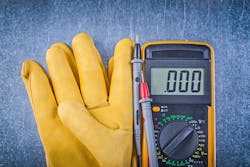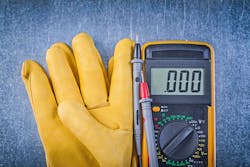Tip of the Week: The Steps in a Safe Test and Measurement Sequence
Using a digital multimeter (DMM) to verify that a circuit is de-energized is a good safety practice. Let’s walk through the steps Carl takes before replacing a motor starter.
- Open the local disconnect.
- Insert the leads in his DMM.
- Set his DMM to AC Volts.
- Place probes on L1 and L2.
- Find the voltage to be zero.
- Begin disconnecting the input power leads.
What did he do wrong?
With this test, he does not know that what he tested is actually “dead.” He knows only that his DMM showed no voltage between L1 and L2. Was his meter working? Maybe he thought it was set to AC Volts, but the selector was in between or even on the wrong mode. Maybe he’s got a bad test lead. Maybe the meter’s automatic protection kicked in and it can’t make the measurement now. Before he does anything, he needs to verify the meter function.
To verify the meter function for a de-energization safety test, do the following:
- Test the DMM on a known “hot” source of similar voltage to the point under test. The DMM should show 480V, or whatever that voltage is.
- Test the disconnected circuit. If the DMM shows zero, that’s good. But one final step remains.
- Repeat the first step. If the DMM show zero, you’ve got a problem. If it shows what it showed the first time, you can be confident it took a correct measurement on the dead circuit.
Carl should not have tested between L1 and L2 and called that verification. For one thing, L3 might have a backfeed on it and be capable of delivering a lethal shock. Testing in that manner also indicates he was probably using both probes at the same time, a mistake that can ignite an arc flash.
A better way to do this is to clip the black lead to a “ground” connection (e.g., an equipment grounding terminal) and use the red probe to test voltage at each of the three supply terminals. If there’s no significant voltage (e.g., all you get is “noise” on the order of millivolts), the circuit is de-energized.
If Carl wanted to be even more certain everything is dead, he could clip onto L1 and put his probe on L2 and then L3. Then clip onto L2 and put his probe on L3. Making sure, of course, he’s using that three-step meter function verification test.
About the Author

Mark Lamendola
Mark is an expert in maintenance management, having racked up an impressive track record during his time working in the field. He also has extensive knowledge of, and practical expertise with, the National Electrical Code (NEC). Through his consulting business, he provides articles and training materials on electrical topics, specializing in making difficult subjects easy to understand and focusing on the practical aspects of electrical work.
Prior to starting his own business, Mark served as the Technical Editor on EC&M for six years, worked three years in nuclear maintenance, six years as a contract project engineer/project manager, three years as a systems engineer, and three years in plant maintenance management.
Mark earned an AAS degree from Rock Valley College, a BSEET from Columbia Pacific University, and an MBA from Lake Erie College. He’s also completed several related certifications over the years and even was formerly licensed as a Master Electrician. He is a Senior Member of the IEEE and past Chairman of the Kansas City Chapters of both the IEEE and the IEEE Computer Society. Mark also served as the program director for, a board member of, and webmaster of, the Midwest Chapter of the 7x24 Exchange. He has also held memberships with the following organizations: NETA, NFPA, International Association of Webmasters, and Institute of Certified Professional Managers.

